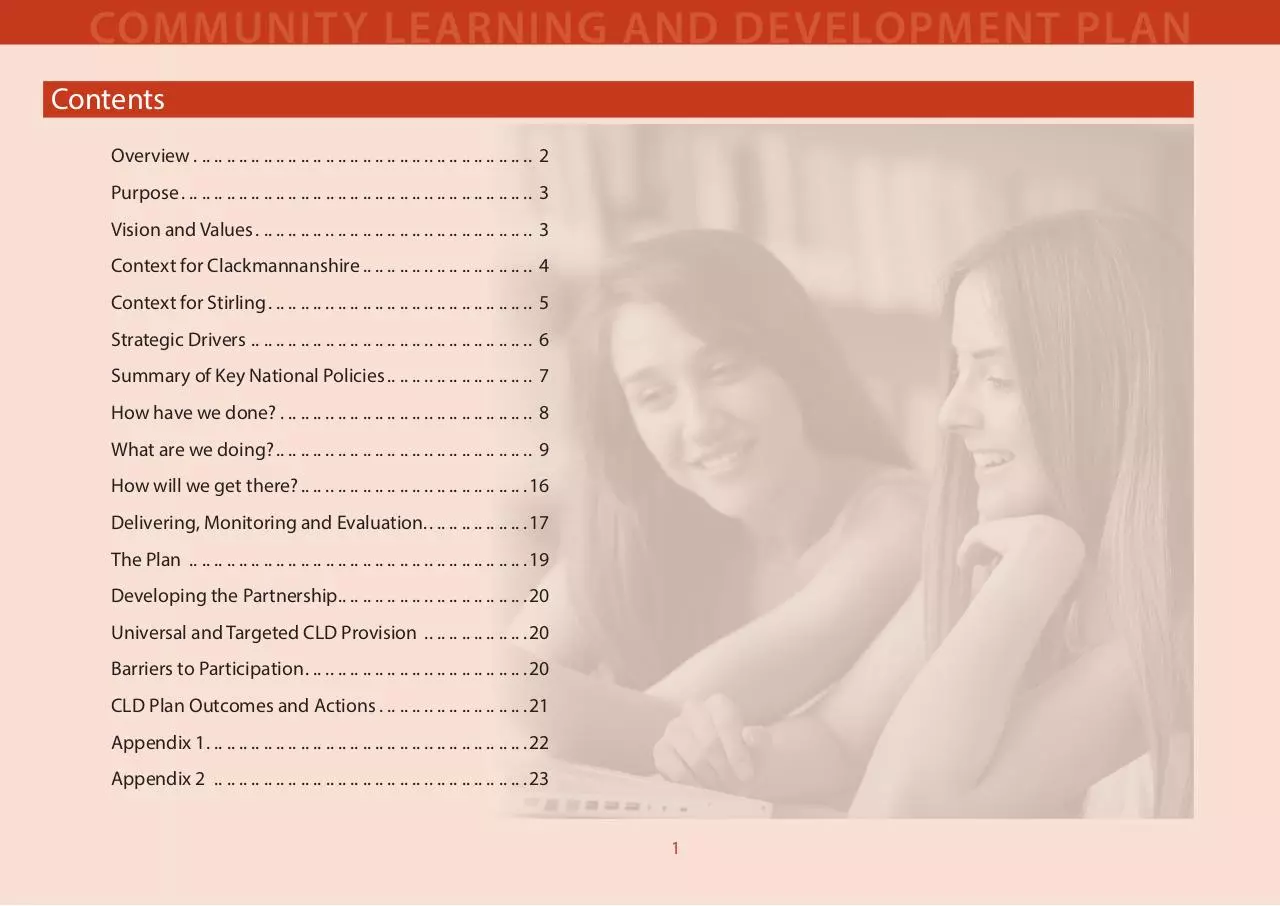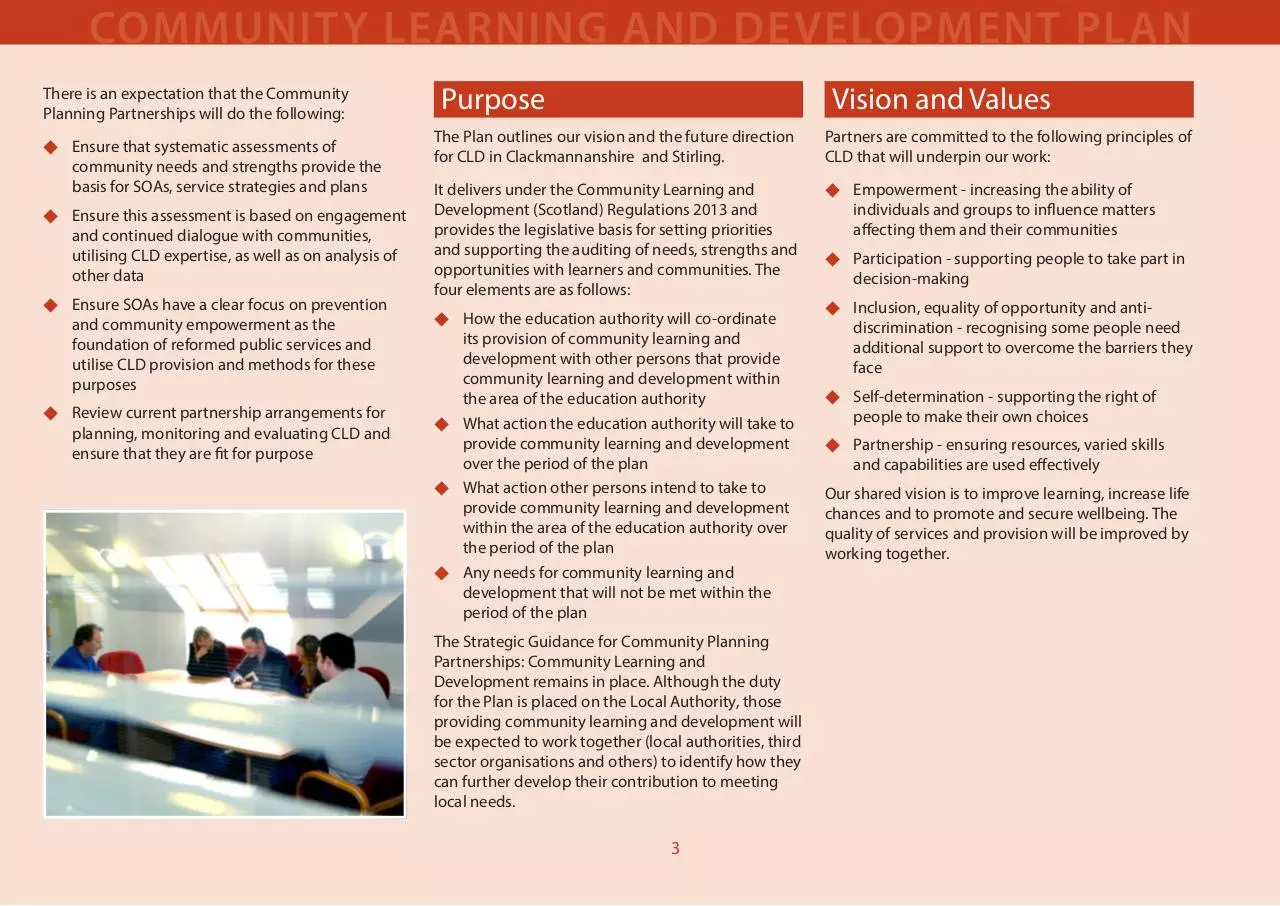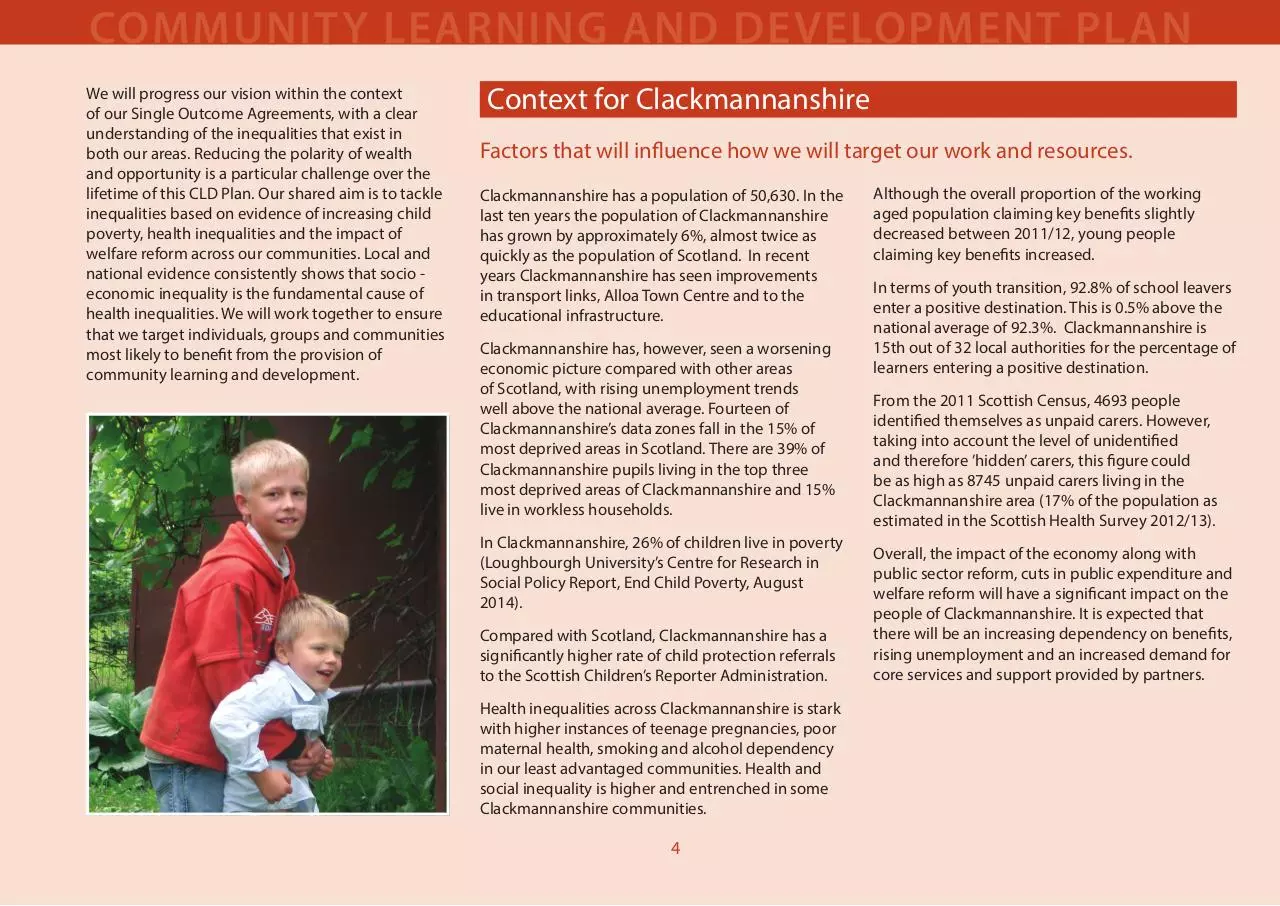CLD Plan (PDF)
File information
This PDF 1.7 document has been generated by Adobe InDesign CS6 (Windows) / Adobe PDF Library 10.0.1, and has been sent on pdf-archive.com on 29/03/2016 at 09:51, from IP address 194.83.x.x.
The current document download page has been viewed 577 times.
File size: 13.12 MB (25 pages).
Privacy: public file





File preview
COMMUNITY LEARNING AND DEVELOPMENT PLAN
A Community Learning & Development Plan
For Clackmannanshire and Stirling
2015 – 2018
COMMUNITY LEARNING AND DEVELOPMENT PLAN
Contents
Overview . . . . . . . . . . . . . . . . . . . . . . . . . . . . . . . . . . . . . . . . . . . . . . . . . . . . . . . 2
Purpose . . . . . . . . . . . . . . . . . . . . . . . . . . . . . . . . . . . . . . . . . . . . . . . . . . . . . . . . . 3
Vision and Values . . . . . . . . . . . . . . . . . . . . . . . . . . . . . . . . . . . . . . . . . . . . . 3
Context for Clackmannanshire .. .. .. .. .. .. .. .. .. .. .. .. .. .. 4
Context for Stirling . . . . . . . . . . . . . . . . . . . . . . . . . . . . . . . . . . . . . . . . . . . 5
Strategic Drivers .. . . . . . . . . . . . . . . . . . . . . . . . . . . . . . . . . . . . . . . . . . . . . . 6
Summary of Key National Policies .. .. .. .. .. .. .. .. .. .. .. .. 7
How have we done? . . . . . . . . . . . . . . . . . . . . . . . . . . . . . . . . . . . . . . . . . 8
What are we doing? .. .. .. .. .. .. .. .. .. .. .. .. .. .. .. .. .. .. .. .. .. 9
How will we get there? .. .. .. .. .. .. .. .. .. .. .. .. .. .. .. .. .. .. 16
Delivering, Monitoring and Evaluation. . . . . . . . . . . . . . . . .17
The Plan .. . . . . . . . . . . . . . . . . . . . . . . . . . . . . . . . . . . . . . . . . . . . . . . . . . . . . . .19
Developing the Partnership .. .. .. .. .. .. .. .. .. .. .. .. .. .. .. 20
Universal and Targeted CLD Provision .. . . . . . . . . . . . . . . . .20
Barriers to Participation . . . . . . . . . . . . . . . . . . . . . . . . . . . . . . . . . . . .20
CLD Plan Outcomes and Actions . . . . . . . . . . . . . . . . . . . . . . . .21
Appendix 1 . . . . . . . . . . . . . . . . . . . . . . . . . . . . . . . . . . . . . . . . . . . . . . . . . . . .22
Appendix 2 .. . . . . . . . . . . . . . . . . . . . . . . . . . . . . . . . . . . . . . . . . . . . . . . . . . .23
1
COMMUNITY LEARNING AND DEVELOPMENT PLAN
Overview
Welcome to the Community Learning and
Development (CLD) Plan for Clackmannanshire and
Stirling Council areas for 2015 - 2018.
Clackmannanshire and Stirling Councils have taken
the decision to produce an integrated plan (as part
of the shared Education and Social Care Services)
across the two council areas. The Plan meets the
requirements of the Community Learning and
Development (Scotland) Regulations 2013, made
under the powers of the Education (Scotland) Act
1980.
The Plan will be made available to the Local Area
Network (LAN). The mechanism for doing this will
be through the annual self - evaluation completed
by the Chief Executive of each Local Authority to
inform the shared risk assessment process. The
work delivered to meet the requirements of the
Regulations will also form a key element of the new
CLD inspection framework that is currently under
development.
ages, through learning, personal development
and active citizenship and through building
stronger, more resilient, supportive, influential
and inclusive communities. We will ensure that we
target individuals and groups most likely to benefit
from the provision of community learning and
development.
The Plan content reflects both national and local
strategic priorities and outcomes and has been
aligned to both Single Outcome Agreements (SOA).
The Plan will show how CLD partners will work
together to deliver on agreed actions and monitor
and review the Plan.
Tell me and I forget, teach me
and I may remember, involve
me and I learn
Benjamin Franklin
Our Community Planning Partnerships will
ensure CLD has a core role in delivering identified
outcomes for communities and addressing
inequalities. This will depend on maximising the
contribution of the following partners:
³³ Services in both local authorities
³³ Those - often in the voluntary sector - in
settings such as community health, housing,
social enterprise, anti-poverty work, equalities
or sustainable development
Community Learning and Development (CLD)
describes a way of working with, and supporting,
individuals and communities. CLD should
empower people, individually and collectively,
to make positive changes in their lives and their
communities through learning.
³³ Public service organisations such as
colleges and universities, the NHS and Skills
Development Scotland
³³ Local communities or communities of interest,
for example ethnic minorities or people with
disabilities, concerned with shaping CLD
services in order to deliver the outcomes that
are important to them
The two Councils and key partners have worked
together to develop this three year Plan which
will, as outlined in the Government’s National
Performance Framework, ensure CLD’s specific
focus is on improved life chances for people of all
³³ Government bodies with an identified CLD
remit and voluntary sector organisations
publicly funded for this purpose
2
COMMUNITY LEARNING AND DEVELOPMENT PLAN
There is an expectation that the Community
Planning Partnerships will do the following:
³³ Ensure that systematic assessments of
community needs and strengths provide the
basis for SOAs, service strategies and plans
³³ Ensure this assessment is based on engagement
and continued dialogue with communities,
utilising CLD expertise, as well as on analysis of
other data
³³ Ensure SOAs have a clear focus on prevention
and community empowerment as the
foundation of reformed public services and
utilise CLD provision and methods for these
purposes
³³ Review current partnership arrangements for
planning, monitoring and evaluating CLD and
ensure that they are fit for purpose
Vision and Values
Purpose
The Plan outlines our vision and the future direction
for CLD in Clackmannanshire and Stirling.
Partners are committed to the following principles of
CLD that will underpin our work:
It delivers under the Community Learning and
Development (Scotland) Regulations 2013 and
provides the legislative basis for setting priorities
and supporting the auditing of needs, strengths and
opportunities with learners and communities. The
four elements are as follows:
³³ Empowerment - increasing the ability of
³³ How the education authority will co-ordinate
its provision of community learning and
development with other persons that provide
community learning and development within
the area of the education authority
³³ What action the education authority will take to
provide community learning and development
over the period of the plan
³³ What action other persons intend to take to
provide community learning and development
within the area of the education authority over
the period of the plan
³³ Any needs for community learning and
development that will not be met within the
period of the plan
The Strategic Guidance for Community Planning
Partnerships: Community Learning and
Development remains in place. Although the duty
for the Plan is placed on the Local Authority, those
providing community learning and development will
be expected to work together (local authorities, third
sector organisations and others) to identify how they
can further develop their contribution to meeting
local needs.
3
individuals and groups to influence matters
affecting them and their communities
³³ Participation - supporting people to take part in
decision-making
³³ Inclusion, equality of opportunity and anti-
discrimination - recognising some people need
additional support to overcome the barriers they
face
³³ Self-determination - supporting the right of
people to make their own choices
³³ Partnership - ensuring resources, varied skills
and capabilities are used effectively
Our shared vision is to improve learning, increase life
chances and to promote and secure wellbeing. The
quality of services and provision will be improved by
working together.
COMMUNITY LEARNING AND DEVELOPMENT PLAN
We will progress our vision within the context
of our Single Outcome Agreements, with a clear
understanding of the inequalities that exist in
both our areas. Reducing the polarity of wealth
and opportunity is a particular challenge over the
lifetime of this CLD Plan. Our shared aim is to tackle
inequalities based on evidence of increasing child
poverty, health inequalities and the impact of
welfare reform across our communities. Local and
national evidence consistently shows that socio economic inequality is the fundamental cause of
health inequalities. We will work together to ensure
that we target individuals, groups and communities
most likely to benefit from the provision of
community learning and development.
Context for Clackmannanshire
Factors that will influence how we will target our work and resources.
Clackmannanshire has a population of 50,630. In the
last ten years the population of Clackmannanshire
has grown by approximately 6%, almost twice as
quickly as the population of Scotland. In recent
years Clackmannanshire has seen improvements
in transport links, Alloa Town Centre and to the
educational infrastructure.
Clackmannanshire has, however, seen a worsening
economic picture compared with other areas
of Scotland, with rising unemployment trends
well above the national average. Fourteen of
Clackmannanshire’s data zones fall in the 15% of
most deprived areas in Scotland. There are 39% of
Clackmannanshire pupils living in the top three
most deprived areas of Clackmannanshire and 15%
live in workless households.
In Clackmannanshire, 26% of children live in poverty
(Loughbourgh University’s Centre for Research in
Social Policy Report, End Child Poverty, August
2014).
Compared with Scotland, Clackmannanshire has a
significantly higher rate of child protection referrals
to the Scottish Children’s Reporter Administration.
Health inequalities across Clackmannanshire is stark
with higher instances of teenage pregnancies, poor
maternal health, smoking and alcohol dependency
in our least advantaged communities. Health and
social inequality is higher and entrenched in some
Clackmannanshire communities.
4
Although the overall proportion of the working
aged population claiming key benefits slightly
decreased between 2011/12, young people
claiming key benefits increased.
In terms of youth transition, 92.8% of school leavers
enter a positive destination. This is 0.5% above the
national average of 92.3%. Clackmannanshire is
15th out of 32 local authorities for the percentage of
learners entering a positive destination.
From the 2011 Scottish Census, 4693 people
identified themselves as unpaid carers. However,
taking into account the level of unidentified
and therefore ’hidden’ carers, this figure could
be as high as 8745 unpaid carers living in the
Clackmannanshire area (17% of the population as
estimated in the Scottish Health Survey 2012/13).
Overall, the impact of the economy along with
public sector reform, cuts in public expenditure and
welfare reform will have a significant impact on the
people of Clackmannanshire. It is expected that
there will be an increasing dependency on benefits,
rising unemployment and an increased demand for
core services and support provided by partners.
COMMUNITY LEARNING AND DEVELOPMENT PLAN
Context for Stirling
Factors that will influence how we will target our work and resources
Stirling has a population of around 90,000 people,
65% of whom are in the City of Stirling and
neighbouring areas and 35% in the rural area. The
Stirling area shows great diversity and, as a whole,
the statistics are generally very positive in relation to
Scotland.
There are, however, communities of concentrated
deprivation where health statistics are some of the
poorest in the country. In Stirling, 17% of children
live in poverty (Loughbourgh University’s Centre for
Research in Social Policy Report, End Child Poverty,
August 2014).
A higher proportion of under–fives live in our most
deprived areas than that of the general population.
Compared with Scotland, Stirling also has a
significantly higher rate of child protection referrals
with parental alcohol or drug misuse.
The beautiful thing about
learning is that nobody can
take it away from you
B.B. King
The latest update to the Scottish Index of Multiple
Deprivation (SIMD) in 2012 showed that most of
Stirling’s most deprived areas have experienced a
consolidation and deepening of deprivation since
2009, further increasing polarisation of the area. This
indicates that Stirling’s deprived areas have been
less resilient to wider economic change than other
parts of Scotland.
Unemployment levels have risen in recent years,
reflecting wide economic conditions: there are
significant variations across communities; in some
areas male unemployment can be as high as 30-40%
whereas in others it barely registers. Youth (16-24)
unemployment is a couple of percentage points
higher than the overall figure and in more deprived
areas, youth unemployment can be at significantly
high levels.
In terms of youth transition, 91.5% of school leavers
enter a positive destination. This is 0.8% below the
national average of 92.3%. Stirling Council is 23rd
of 32 local authorities for the percentage of learners
entering a positive destination.
From the 2011 Scottish Census, 8260 people
identified themselves as unpaid carers. However
taking into account the level of unidentified and
therefore ‘hidden’ carers, this figure could be as high
as 15,000 unpaid carers living in the Stirling area
(17% of the population as estimated in the Scottish
Health Survey 2012/13).
5
Rural Stirling has generally lower unemployment
and income deprivation than the wider council
area. However, there is polarisation of employment
from managers/professionals through to lower
paid workers in hospitality and retail. Most of the
northern part of Stirling’s rural area lies within the
most deprived 5% nationally for accessibility to
facilities such as GPs, shops and schools.
Overall, there are significant variations within
Stirling: in household structure, income, economic
activities and housing. The ACORN classification
describes households based on their lifestyle,
behaviour and attitudes, irrespective of where they
are located. Around one in seven of Stirling’s most
deprived households (termed ‘struggling families’
and ‘burdened singles’) are in rural areas. At the
other end of the scale, two thirds of rural households
are in the most affluent categories.
COMMUNITY LEARNING AND DEVELOPMENT PLAN
Strategic Drivers
This three year Plan will contribute towards a range
of key local and national strategies and policies,
including both Clackmannanshire and Stirling
Single Outcome Agreement priorities.
Community planning partners are committed to
working together towards the Strategic Outcomes
defined within the Agreements (2013 - 2023).
Clackmannanshire
Stirling
³³ Clackmannanshire has a positive image and
³³ Improved outcomes in children’s early years
attracts business and people
³³ Communities are more inclusive and cohesive
³³ Improved support for disadvantaged and
vulnerable families and individuals
³³ People are better skilled, trained and ready for
³³ Communities are well served, better connected
³³ Communities are and feel safer
³³ Improved supply of social and affordable
learning and employment
³³ Vulnerable people and families are supported
³³ Substance misuse and its effects are reduced
³³ Health is improving
³³ Our environment is protected and enhanced
³³ Our public services are improving
and safe
housing
³³ Reduced risk factors that lead to poor health
and other inequalities
³³ Improved opportunities for learning, training
and work
³³ A diverse economy that delivers good quality
local jobs
6
COMMUNITY LEARNING AND DEVELOPMENT PLAN
Summary of Key National Policies
CLD Strategic Guidance - The guidance outlines
the action necessary to maximise CLD’s impact,
resulting in better alignment of services and
optimal use of resources. The implementation of
the guidance must be led by Community Planning
Partnerships, with support from Government bodies
such as Education Scotland and with national
and local Third Sector partners. It should form an
integral part of public service reform, ensuring that
Community Planning provides the vehicle to deliver
better outcomes in partnership with communities.
Adult Learning in Scotland, Statement of
Ambition (2014) – This document outlines the
aspiration that Scotland becomes recognised
globally as the most creative and engaged learning
society; every adult in Scotland will have the right to
access learning to meet their educational needs and
their aspirations; and Adult learning in Scotland, and
the outcomes that learners achieve, will be worldleading. The statement has three core principles
that adult learning should be: lifelong, life-wide and
learner centred.
Youth Work Strategy – This strategy aims to ensure
that all young people, in every part of Scotland,
should have access to high quality and effective
youth work practice. This can be achieved by
working together with young people, community
planning partnerships, relevant organisations and
other partners.
Community Empowerment (Scotland) Act The purpose of the Act is to make it easier for
communities to achieve their goals, by giving
them clear statutory rights to be more proactive in
determining service provision, delivering services
and owning/managing assets.
Getting It Right For Every Child (GIRFEC) – The
GIRFEC approach aims to improve the wellbeing
of all children and young people by improving
assessment, decision making, planning and multiagency working.
7
Curriculum for Excellence – The curriculum aims
to ensure that all children in Scotland develop
their capacities as: successful learners, confident
individuals, responsible citizens and effective
contributors to society.
Early Years Framework – This framework is about
ensuring that every child has the best start in life
and that they get the support required to enable
them to fulfil their potential.
COMMUNITY LEARNING AND DEVELOPMENT PLAN
ESOL Strategy - This strategy aims to ensure that
all Scottish residents for whom English is not a
first language have the opportunity to access high
quality English language provision so that they
can acquire the language skills to enable them to
participate in Scottish life: in the workplace, further
study, within the family, the local community,
Scottish society and the economy.
Developing Young Workforce – This strategy
provides a blueprint to substantially and
permanently improve the transition of all young
people from education into sustainable, productive
employment.
Equally Well – This report brings together thinking
on poverty, lack of employment, children’s lives
and support for families and physical and social
environments, as well as on health and wellbeing.
It makes clear that we will not only respond to the
consequences of health inequalities, but also tackle
its causes. The Task Force recognised that success
will be a long-term achievement but that short-term
gains can still be made.
Keys to Life – This strategy has the human rights
of people with learning disabilities at its heart. Also
integral to it is The Healthcare Quality Strategy for
NHS Scotland2, published in 2010, which makes
clear that whatever the individual circumstances
of people’s lives, including age, gender, ethnicity,
disability, religion, sexual orientation, mental health,
economic or other circumstances, they should have
access to the right health services for their needs.
Partnership Matters – The guidance document
describes the roles and responsibilities of all
agencies supporting people with additional support
needs who wish to study, or are currently studying
at Scotland’s colleges or universities. Partnership
Matters is about removing barriers faced by people
with additional support needs. This is not solely
the responsibility of the colleges or universities. All
agencies have a role to play whether by providing
personal care, health care, transport or other forms
of support.
Commission on the future delivery of Public
Services – This report on the commission, led by Dr
Campbell Christie, suggests that a radical change
in the design and delivery of public services is
necessary, irrespective of the current economic
challenges, to tackle the deep rooted social
problems that persist in communities across the
country.
Caring Together: The Carers Strategy for
Scotland – The strategy sets out 10 key actions
to improve support to unpaid carers. The focus is
on improved identification of carers, assessment,
information and advice, health and wellbeing, carer
support, participation and partnership.
8
How have we done?
External Scrutiny
HMIe has recently inspected and published
reports on CLD activity across some of the learning
communities in Clackmannanshire and Stirling. The
key findings were as follows:
Common strengths across Clackmannanshire and
Stirling
³³ Strong and vibrant community organisations
³³ Dedication and commitment of local people as
skilled and enthusiastic volunteers
³³ Effective engagement with learners
³³ Partners working well at a local level
Areas for development across Clackmannanshire
and Stirling
³³ Sharing of data across CLD partners to ensure
that there is a co-ordinated approach to
targeting work, sharing priorities and improving
services
³³ Improved joint self-evaluation across schools
and CLD providers to support and develop
performance
³³ Improved arrangements for the planning and
delivery of CLD across learning communities
Download CLD Plan
CLD Plan.pdf (PDF, 13.12 MB)
Download PDF
Share this file on social networks
Link to this page
Permanent link
Use the permanent link to the download page to share your document on Facebook, Twitter, LinkedIn, or directly with a contact by e-Mail, Messenger, Whatsapp, Line..
Short link
Use the short link to share your document on Twitter or by text message (SMS)
HTML Code
Copy the following HTML code to share your document on a Website or Blog
QR Code to this page

This file has been shared publicly by a user of PDF Archive.
Document ID: 0000354170.